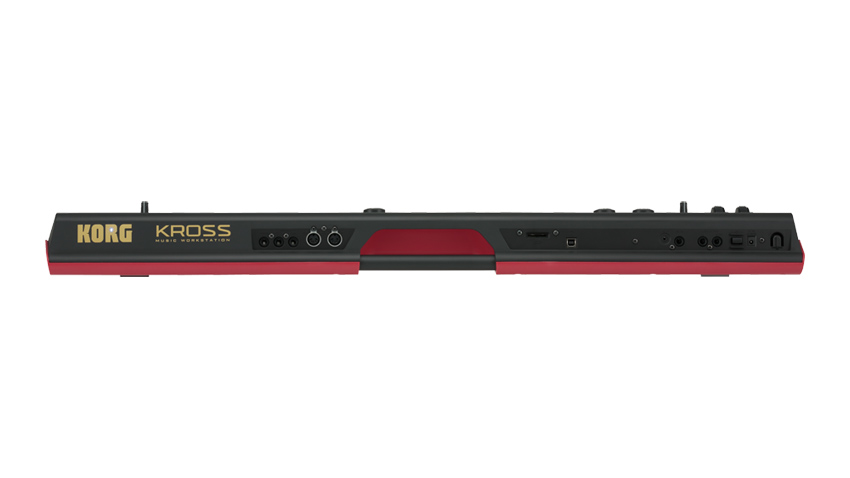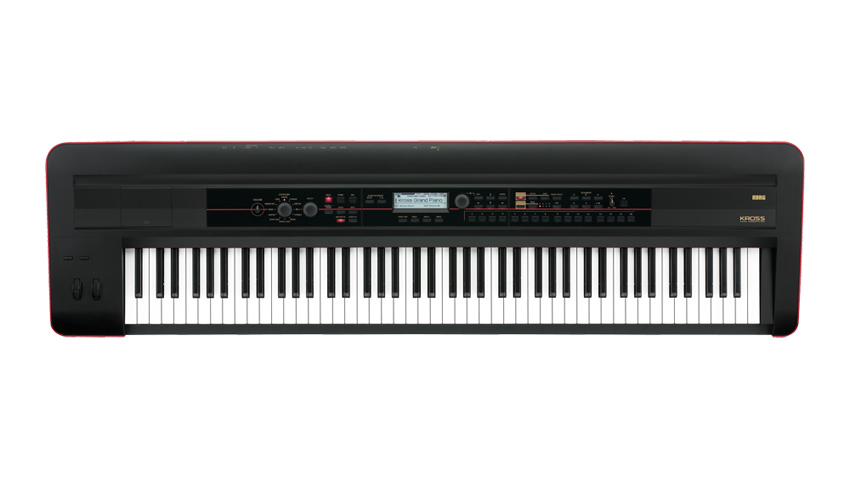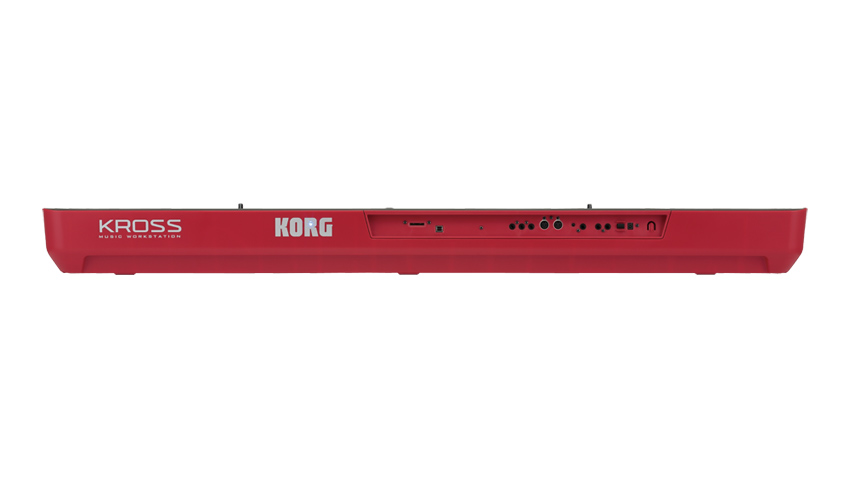Musikmesse 2013: Korg reveals Kross compact workstation
61- and 88-note models can run on six AA batteries

Korg Kross

Korg Kross 61 rear

Korg Kross 88

Korg Kross 88 rear
MUSIKMESSE 2013: Korg's Kross is the company's new portable workstation keyboard. As always with these things, the pitch is that it provides great sounds and a built-in sequencer so that you can make tracks with them. You also get a mic input and built-in audio recorder.
The Kross's portable nature is confirmed by the fact that it'll run on six AA batteries. It comes in 61- and 88-note configurations and sports a step sequencer that's lifted from the Electribe.
We'll keep you posted with pricing and release details. For now, you can learn more below or on the Korg website.
Korg Kross official information
With the KROSS, the sounds and songs that you've created at home and the system that you use every day can go with you onto the stage or into the street! Featuring rich sounds that exceed its class, yet remaining highly portable, the KROSS is designed for practical usability. There's a convenient mic input and a built-in audio recorder, and it can run on 6 x AA batteries. It's a distinctive new standard in music workstations, with specs and style that set it apart from all others.
Product Highlights:
- Stylish and distinctive red and black two-tone color design
- The lightweight body is only 4.3 kg/9.5 lbs (61-key model) or 12.4 kg/27.3 lbs (88-key model), and can be powered by 6x AA batteries
- Piano, electric piano, and drum sounds that exceed its class
- A wide variety of sounds that utilize twice as much PCM memory as previous instruments, and meet the needs of a broad range of musical styles
- Sound Selector makes it easy to find the sound you're looking for
- Favorites function lets you register 64 selected sounds or audio songs for one-touch access - a great feature for live performances
- Pro-quality EDS-i sound engine built-in, with a total of seven effects available for simultaneous use
- External input jacks allow a mic or external audio source to be directly connected.
- Quick Layer/Split function for on-the-fly versatility
- Stereo audio recorder allows you to record and overdub your performances and vocals
- Step sequencer inherited from the Electribe, a 16-track MIDI sequencer, a drum track, and an arpeggiator
- Connects to your computer via USB for plug-in integration with your favorite DAW
The creative color and design will project a powerful presence whether you're performing on stage or anywhere else. The top panel as seen by the player is a sleek black color, while the rear and side panels visible by the audience use a bold, red color scheme. The two models feature different design concepts; the 61-key model is designed for active mobile use, while the 88-key model has a sophisticated design that looks great on stage.
A lightweight body that runs on AA alkaline batteries
In spite of being packed with functionality, the KROSS is lightweight and highly portable. The 61-key model with its distinctive rear bar is amazingly light; at only 4.3 kg/9.5 lb, it's the most portable in its category. The 88-key model packs a piano-touch hammer action keyboard into a mere 12.4 kg/27.3 lbs. Both models are highly portable and lightweight, and can operate on an AC adapter or on six AA alkaline or nickel-metal hydride batteries.
Top professional musicians around the world use Korg synthesizers. The piano, electric piano, and drum sounds of the KROSS have been taken from the flagship instruments used by these pros, giving the KROSS a set of sounds that surpasses other instruments in its class. The grand piano features lavishly-sampled decays with three levels of velocity as well as reproducing the noises produced by the damper pedal, ensuring that every nuance of your performance is reflected in the sound. Also included are an upright piano (unusual for a PCM synth), as well as distinctive sounds from Korg's famed SG-1D Sampling Grand and M1 Music Workstation. The five classic electric piano sounds are just as expressive as the acoustic piano sounds; they also include effect settings, giving you a complete package of the performance-ready sounds that you want. In addition, careful attention has been paid to the drum sounds that are indispensable for song production on a workstation, making them realistic and fresh.
Get the MusicRadar Newsletter
Want all the hottest music and gear news, reviews, deals, features and more, direct to your inbox? Sign up here.
A wide variety of sounds
Because of its portability, the KROSS will be used in a wide range of situations, and that's why it provides a broad variety of sounds that surpasses even the flagship models of the previous generation. The PCM data is approximately twice as large as preceding models such as the X50 and the PS60. Staples such as the frequently-used rock/jazz organ, strings, brass, and synth sounds have been brushed up. There are also instruments such as toy piano, accordion, combo organ, church organ, and even vintage instruments such as a tape sampler, as well as bell-type sounds and the sounds you need for cutting-edge dance music and electronica - unique sounds that have not been included in a synth of this class. Our design goal has been to make KROSS the only instrument you need.
Sound Selector makes it easy to find the sound you're looking for
While the KROSS provides an extremely broad range of sounds, there are two dedicated dials that let you easily find the sound you need. First use the category dial to choose the broad category such as piano, electric piano, organ, bell, synths, basses, or strings. Then turn the select dial to find the sound you want. It's a quick way to focus on selecting the needed sounds without being distracted by sounds of another type.
Favorites function lets you register 64 selected sounds or audio songs for one-touch access
Sounds that you've created or that you use frequently can be registered to four banks of 16 buttons, giving you a total of 64 sounds that can be recalled at a single touch. This is a real convenience during live performances or song production. You can also register audio songs and recall them along with sounds.
Pro-quality EDS-i sound engine is built-in
The EDS-i sound engine is a high-quality sound engine distilled from the EDS/EDS-X sound engines found on Korg's most advanced instruments. It allows you to use a total of seven effects simultaneously: five insert effects and two master effects. Ranging from standards such as delay, reverb, chorus, flanger, and rotary speaker, and also including amp modeling powered by Korg's proprietary "REMS" modeling technology, and even a robot voice vocoder, you can choose from 134 different high-quality effects.
The MIC IN jack (1/4" phone jack) lets you directly connect a mic. If you're a vocalist as well as a player, there's no need to obtain a separate mixer. In addition, there's a LINE IN jack (stereo 1/8" jack) for you to connect your audio player, giving you the option of performing along with the playback in a variety of situations on stage or anywhere else you go.
Quick Layer/Split function
Dedicated buttons are provided for Layer/Split settings. Start by selecting the first program you want to use; then press the dedicated button to enable Layer or Split. When this is on, a screen will appear in which you can choose the other sound and specify details such as the split point. Then simply write your settings and the layer/split sound will be saved as a Combination.
Stereo audio recorder allows you to overdub your performances and vocals
The built-in stereo audio recorder can record not only the performance of the KROSS itself, but also the sound of a mic or external input. You can play backing tracks that you created, or overdub onto them to create songs and demos. Audio can be imported and exported as WAV files using an SD card (separately sold), making it easy to exchange material with your computer.
The KROSS features a step sequencer inherited from the popular Electribe series. It's a simple design in which you use the sixteen buttons to turn individual notes on or off, allowing you to quickly and easily create original rhythm patterns of up to 64 steps. The lightweight body of the KROSS contains all of the basic functionality you expect from a music workstation, including a full-featured 16-track MIDI sequencer with quantization, copy and paste, and individual note event editing. By using an SD card (sold separately), you can exchange SMF-format data with your computer. The KROSS gives you a full set of workstation and production tools, including a Drum Track function that lets you add rhythm simply by pressing a dedicated button, and an arpeggiator that can be used not only with synth sounds but also to generate guitar and bass riffs.
Connects to your computer via USB
You can connect the KROSS to your computer via USB for easy transfer of MIDI data. By using KROSS Editor and Plug-In Editor you can simultaneously view and edit large numbers of parameters on your computer, and use the KROSS within your DAW as if it were a software synthesizer.
*KROSS Editor and Plug-In Editor can be downloaded from the Korg website.



I’m the Deputy Editor of MusicRadar, having worked on the site since its launch in 2007. I previously spent eight years working on our sister magazine, Computer Music. I’ve been playing the piano, gigging in bands and failing to finish tracks at home for more than 30 years, 24 of which I’ve also spent writing about music and the ever-changing technology used to make it.
Don’t miss this record-breaking 100-Hour DJ marathon livestream fundraiser featuring 90 artists
“It's our passion to bring songwriting back to the historic heart of the West End”: An all-new, star-studded writer’s retreat is aiming help make history in London’s iconic Denmark Street









